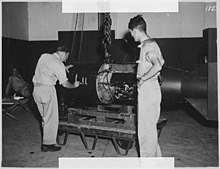Project Alberta
Project Alberta was formed in March 1945, and consisted of 51 United States Army, Navy, and civilian personnel, including one British scientist.
After completion of its development and training missions, Project Alberta was attached to the 509th Composite Group at North Field, Tinian, where it prepared facilities, assembled and loaded the weapons, and participated in their use.
[3][11] Parsons became the head of Project Alberta, with Ramsey as his scientific and technical deputy, and Ashworth as his operations officer and military alternate.
[13] Physicists Robert Serber and William Penney, and US Army Captain James F. Nolan, a medical expert, were special consultants.
[16] Army personnel were two officers, Nolan and First Lieutenant John D. Hopper, and 17 enlisted men from the Manhattan Project's Special Engineer Detachment.
[13] In addition, there were three senior officers on Tinian, who were part of the Manhattan Project but not formally part of Project Alberta: Rear Admiral William R. Purnell, the representative of the Military Liaison Committee; Brigadier General Thomas F. Farrell, Groves' Deputy for Operations; and Colonel Elmer E. Kirkpatrick, who was responsible for base development, and was Farrell's alternate.
In February 1945, Ashworth traveled to Guam bearing a letter for Fleet Admiral Chester W. Nimitz informing him of the Manhattan Project.
[21] Up to this point it had been expected that the 509th Composite Group would be based on Guam, but Ashworth was struck by the congestion in the harbor and the shortage of construction units there.
USAAF suggested that he take a look at Tinian, which had two good airfields, and was 125 miles (201 km) further north, an important consideration for potentially overloaded aircraft.
Ashworth toured Tinian with the island commander, Brigadier General Frederick V. H. Kimble, who recommended North Field.
A Project Alberta Advance Party was created, consisting of Sheldon Dike for Air Force liaison, Theodore Perlman for Little Boy, and Victor Miller and Harlow Russ for Fat Man.
Accompanied by Major Bud Uanna and other members of the 1st Technical Service Detachment, they flew in C-54 "Green Hornets" of the 509th Composite Group's 320th Troop Carrier Squadron via the Port of Aerial Embarkation at Hamilton Field, California, and arrived on Tinian on 23 June.
[27] Sheldon Dike accompanied bombers of the 509th Composite Group's 393d Bombardment Squadron on practice bombing missions against airfields on Japanese-held Truk, Marcus, Rota, and Guguan.
[31] Nolan arrived on 26 July on the cruiser USS Indianapolis, along with Major Robert Furman and Captain Charles H. O'Brien of the 1st Technical Services Detachment, with the Little Boy assembly and active material.
Jesse Kupferberg and Raemer Schreiber arrived by C-54 with the remainder of the Little Boy active material and the plutonium Fat Man pit.
[34] Project Alberta's Sheldon Dike and Milo Bolstead flew on some of these missions, as did the British observer Group Captain Leonard Cheshire.
"[41] Assembly of a Fat Man unit was a complex operation involving personnel from the HE-ME, Pit, Fusing and Firing teams.
[42] Three sets of Fat Man high explosive pre-assemblies, designated F31, F32, and F33, arrived on a B-29 of the 509th Composite Group and 216th Army Air Forces Base Unit on 2 August.
[44] Consideration was given to evacuating the 20,000 personnel on Tinian from the island, but instead it was decided to load the four cordite powder bags into the gun breech to arm the bomb in flight.
Parsons and his assistant, Second Lieutenant Morris R. Jeppson of the 1st Ordnance Squadron, made their way into the bomb bay of the Enola Gay along the narrow catwalk on the port side.
Before climbing to altitude on approach to the target, Jeppson switched the three safety plugs between the electrical connectors of the internal battery and the firing mechanism from green to red.
[46][52] Purnell, Parsons, Tibbets, Spaatz and Curtis LeMay met on Guam on 7 August, the day after the Hiroshima attack, to discuss what should be done next.
Project Alberta's Walter Goodman and Lawrence H. Johnston were on board the instrumentation aircraft, The Great Artiste, along with William L. Laurence, a correspondent for The New York Times.
[54] Project Alberta's Robert Serber was supposed to be on board but was left behind by the aircraft commander, group operations officer Major James I. Hopkins Jr., because he had forgotten his parachute.
Since Serber was the only crew member who knew how to operate the high-speed camera, the whole point of the aircraft's mission, Hopkins had to be instructed by radio from Tinian on its use.
The plutonium bomb did not require arming in flight, but did have its safeties removed 30 minutes after the 03:45 takeoff when Bockscar reached 5,000 feet (1,500 m) of altitude.
[56] It was discovered that the red arming light on the black box connected to Fat Man was lit, indicating that the firing circuit had closed.
The bomb run began at 11:58 (two hours behind schedule) using radar; but the Fat Man was dropped visually when a hole opened in the clouds at 12:01.
Trying in vain for 20 minutes to contact the control tower at Yontan Airfield to obtain landing clearance, Bockscar nearly ran out of fuel.
[57] Farrell organized a mission to assess the damage done at Hiroshima and Nagasaki, which included personnel from Project Alberta, the 1st Technical Service Detachment, and the 509th Composite Group.





